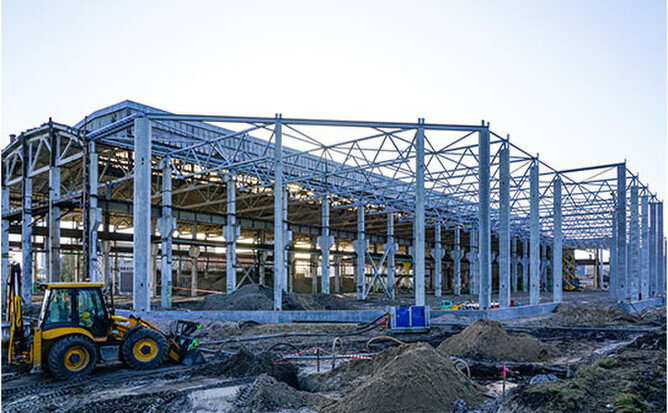Warehouse construction cost per square foot changes based on multiple factors that affect the total budget. Construction expenses differ depending on location, land prices, materials, labor, and building size. Business owners and developers looking to build warehouses need a clear estimate before committing to a project. The final price varies based on market conditions, design requirements, and the specific needs of the business. Here is a closer look at the key factors influencing warehouse construction pricing.
Location Greatly Impacts Warehouse Construction Costs
Geographic location affects warehouse pricing due to differences in land value, labor rates, and material availability. Building in high-demand metropolitan areas increases costs, while rural locations tend to offer lower rates. Proximity to transportation hubs, supply chains, and workforce availability also plays a role in determining total expenses. Cities with strong economic activity see higher construction costs due to competition for resources and skilled labor.
Local building codes and zoning laws further influence pricing. Regulations may require additional permits, inspections, or modifications to the design. These factors add to the total expense and may extend project timelines. Developers planning warehouse construction must research regional costs to make informed financial decisions.
Land Acquisition Costs Vary by Market Demand
Purchasing land is one of the largest expenses in warehouse construction. Urban locations with strong commercial activity have higher land prices, making the total investment significantly greater. The closer a site is to major highways, ports, and industrial centers, the more expensive the land becomes. Businesses needing immediate access to supply chain networks often pay a premium for prime locations.
In contrast, land in rural or less developed areas remains more affordable. However, these sites may require additional infrastructure improvements, such as roads, utilities, and drainage systems. Factoring in these additional costs ensures that land acquisition aligns with budget expectations. Market conditions and real estate demand continue to shape pricing trends for industrial development.
Building Materials Influence Total Construction Budget
Material selection impacts overall warehouse cost due to fluctuations in pricing and availability. Steel, concrete, and prefabricated metal structures are common choices, each offering different durability and cost benefits. Steel prices vary based on global supply and demand, while concrete costs depend on regional production rates. Choosing cost-effective yet durable materials helps maintain long-term structural integrity without exceeding the budget.
Sourcing materials locally can reduce transportation costs, making construction more affordable. However, projects requiring specialized components may face higher expenses if materials must be shipped from distant suppliers. Developers must balance cost, durability, and lead times when selecting materials for warehouse construction.
Labor Costs Differ Across Various Geographic Regions
Hiring skilled labor for warehouse construction contributes significantly to overall expenses. High-demand areas with strong economies tend to have higher wages for construction workers, electricians, and plumbers. Competitive job markets increase labor costs, making warehouse projects more expensive in regions with limited skilled workforce availability.
Labor shortages may also drive up wages, especially in areas experiencing rapid industrial growth. Developers planning warehouse construction in high-cost labor markets should factor in increased wages, benefits, and potential delays due to workforce shortages. Regions with a surplus of experienced workers may offer more competitive rates, reducing overall labor expenses.
Site Preparation Costs Depend on Land Conditions
Before construction begins, the land must be prepared to support the warehouse structure. Site preparation includes grading, excavation, soil testing, and drainage installation. Properties with uneven terrain, poor soil quality, or environmental restrictions require additional work, increasing costs. Industrial sites with existing infrastructure may reduce preparation expenses by minimizing the need for extensive modifications.
Developers must assess potential challenges such as flood zones, seismic activity, or contamination risks. Addressing these factors early prevents costly delays and unexpected expenses. Proper site preparation ensures that the warehouse foundation remains stable and compliant with safety regulations.
Warehouse Size Affects Price Per Square Foot
The overall warehouse footprint significantly impacts the total cost per square foot. Larger buildings often have lower costs per square foot due to economies of scale, while smaller warehouses may have higher expenses due to fixed overhead costs. Spacing requirements for storage, loading docks, and office areas also affect pricing.
Custom warehouse designs with complex layouts or specialized features add to construction expenses. High ceilings, mezzanines, and temperature-controlled spaces require additional materials and labor. Choosing a design that meets operational needs while optimizing square footage helps control construction costs.
Roofing and Insulation Choices Change Overall Pricing
Selecting the right roofing and insulation materials influences warehouse energy efficiency and long-term maintenance costs. Metal roofs offer durability and longevity but may come with higher upfront costs. Flat roofs with membrane coatings provide cost-effective solutions but may require more frequent maintenance. Climate conditions and weather exposure determine the best roofing options for each project.
Insulation plays a critical role in regulating temperature and reducing energy consumption. Warehouses requiring temperature-sensitive storage may need high-quality insulation, increasing construction costs. Choosing materials with strong thermal resistance ensures cost-effective heating and cooling while maintaining operational efficiency.
Flooring Type Impacts Durability and Maintenance Costs
Flooring selection plays a significant role in warehouse longevity and maintenance expenses. Concrete remains the most common option due to its durability and cost-effectiveness. Polished concrete provides a smooth surface that resists wear and tear, making it suitable for high-traffic areas. Epoxy coatings add a layer of protection, preventing damage from heavy machinery and chemical spills. High-impact flooring solutions minimize long-term maintenance while ensuring a stable surface for operations.
Some warehouses require specialized flooring based on usage. Temperature-controlled storage facilities may need insulated floors to maintain efficiency. Warehouses handling chemicals or moisture-sensitive goods benefit from sealed or treated surfaces that prevent degradation. The right flooring solution balances cost, durability, and functionality, reducing maintenance needs while ensuring operational efficiency.
HVAC and Ventilation Systems Influence Energy Bills
Temperature control systems directly impact warehouse energy expenses. Warehouses storing temperature-sensitive products require advanced HVAC systems to maintain consistent conditions. Heating and cooling units must match the facility’s size and insulation levels to prevent energy waste. Inefficient systems increase utility bills and reduce long-term cost savings. Proper ventilation ensures air circulation, preventing moisture buildup and maintaining indoor air quality.
Installing energy-efficient HVAC systems helps lower operating costs. High-performance units with programmable controls optimize climate regulation while reducing electricity consumption. Insulation and airflow management improve efficiency, minimizing the need for excessive heating or cooling. Warehouse owners investing in modern HVAC solutions experience long-term energy savings and improved working conditions.
Utility Connections Add Expenses to Initial Budget
Connecting a warehouse to electricity, water, gas, and sewage systems contributes to upfront costs. Urban locations with existing infrastructure offer easier access to utilities, reducing installation expenses. Rural or undeveloped areas require extensive work to establish connections, increasing overall project costs. Larger facilities with high energy demands may require upgraded electrical panels and transformers to handle power loads.
Permitting and regulatory approvals add to expenses when extending utility services. Water and sewage lines must meet local requirements, and gas installations need specialized handling for safety compliance. Developers must assess infrastructure availability before finalizing warehouse site selection to prevent unexpected utility costs.
Safety and Security Features Increase Construction Costs
Installing security measures enhances warehouse protection but adds to construction expenses. Surveillance cameras, access control systems, and perimeter fencing help prevent unauthorized entry. Fire suppression systems, including sprinklers and alarms, ensure compliance with safety regulations. Facilities handling hazardous materials require additional safety protocols, such as explosion-proof lighting and ventilation systems.
Security investments reduce potential losses from theft, accidents, and damage. Well-lit areas, reinforced entry points, and on-site monitoring improve overall protection. Developers incorporating security features from the design phase avoid costly retrofits while maintaining compliance with industry standards.
Storage Racking Systems Affect Space Utilization Costs
Warehouse layout determines storage efficiency and affects overall expenses. Standard pallet racking provides cost-effective organization for inventory, while automated storage systems increase operational speed but require higher investments. Facilities handling bulk materials or specialized goods need customized shelving solutions tailored to their storage requirements.
The choice of racking systems impacts warehouse space utilization. High-density storage configurations maximize available square footage, reducing the need for larger building footprints. Adjustable shelving and modular designs allow for future expansion, making it easier to adapt to business growth without major renovations.
Local Building Permits and Fees Add to Budget
Warehouse construction requires permits, zoning approvals, and inspection fees, all of which influence the final budget. Each municipality has specific regulations governing industrial developments, and failing to comply leads to delays and penalties. Permitting costs vary based on project scope, location, and environmental impact assessments.
Developers must account for plan reviews, engineering approvals, and compliance inspections. Some areas enforce additional impact fees for infrastructure improvements, increasing upfront costs. Securing permits early prevents unexpected expenses and ensures construction remains on schedule.
Ongoing Maintenance Costs Depend on Material Choices
Material selection affects long-term maintenance expenses. High-quality steel and reinforced concrete require less upkeep, while cheaper alternatives may lead to costly repairs. Roofing materials impact maintenance schedules, with metal roofs offering longevity and reduced upkeep compared to asphalt-based options. Insulation choices influence energy costs, with well-insulated warehouses lowering heating and cooling expenses.
Routine maintenance extends warehouse lifespan and reduces repair costs. Facilities using durable materials experience fewer structural issues, minimizing operational disruptions. Investing in high-quality materials during construction prevents frequent maintenance and ensures cost efficiency over time.
Build With The Best: Warehouse Construction Contractors New York | PE Builders
Warehouse construction requires careful planning, from material selection to energy-efficient systems. Every decision impacts long-term expenses, affecting maintenance, storage efficiency, and security. Choosing the right warehouse construction contractors in New York ensures that each detail meets industry standards while staying within budget. We design and build warehouses that maximize durability, efficiency, and functionality.
Our team at PE Builders specializes in designing and constructing high-performance warehouses built to last. We work closely with clients to deliver projects that optimize space, reduce energy consumption, and meet industry demands. Contact PE Builders today to discuss your warehouse project and get an expert estimate.

